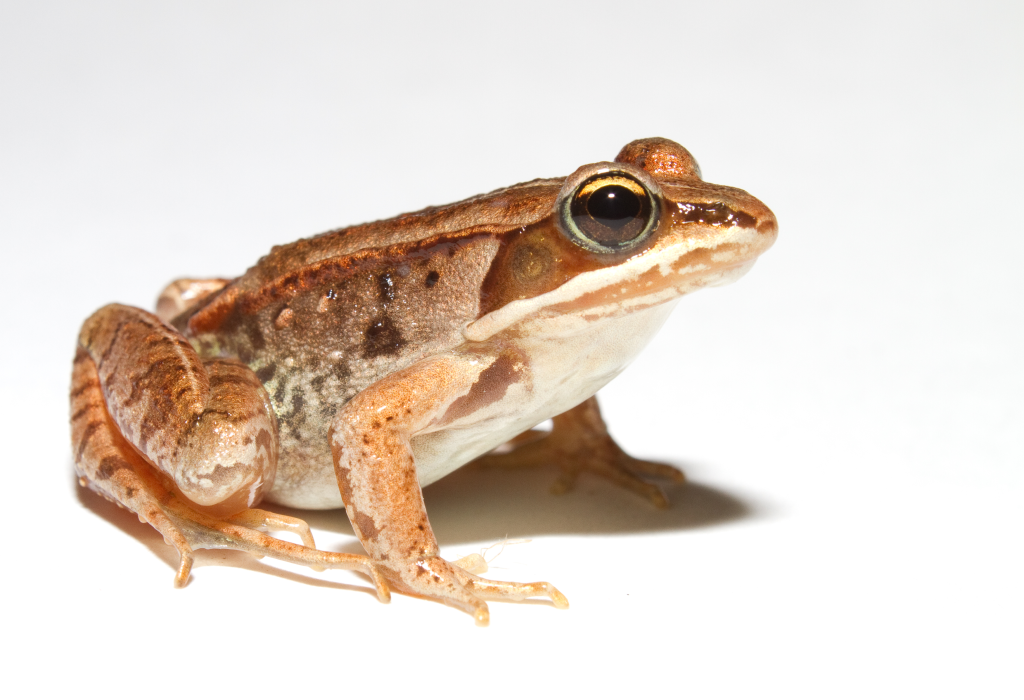Written by Lauren Bell, Library Services Coordinator | Lori Blahey is a former Senior Marketing Consultant at EPL.
September…kids are back in school and we’ve closed on another amazing Summer Starts at EPL with over 138,000 hours read. Like it or not, fall is here, and we’ll soon be planning our winter activities. As Edmontonians, we need to start planning ahead. Did you know that there are many animals who prepare for winter in interesting and unique ways? If you need some inspiration, check out these four creatures and their seasonal superpowers!
The Wood Frog (Lithobates sylvaticus)
Have you ever heard a sound like a duck far past sunset? You may have heard a wood frog. These diminutive amphibians have a big super power: they can freeze solid! They dig down deep into the mud, stop breathing and their hearts stop beating. Their body even produces a special frog anti-freeze so that their cells don’t fill with ice. Instead, ice forms between the cells. In the spring, the frogs thaw and start singing (or quacking) again. Talk about a “frogsicle!”
The National Wildlife Federation (n.d). Wood Frog. Retrieved from https://www.nwf.org/Educational-Resources/Wildlife-Guide/Amphibians/Wood-Frog
Want to learn more?
Check out:
- Juvenile: Wood Frogs by Doug Wechsler.
- Adult: The Amphibians and Reptiles of Alberta: A Field Guide and Primer of Boreal Herpetology by Anthony P Russell. Also available as an eBook.
The Black Bear (Ursus americanus)
If you’ve driven through the Rocky Mountains during your summer vacation, or even visited some nearby lakes, you might have been lucky enough to spot a black bear. Don’t be fooled, black bears come in a variety of colours, from light blonde, to brown, to dark black. When the summer starts to fade, black bears work hard at building up body fat for the upcoming winter months. They find a cozy place to bed down, their body temperature and heart rate drops, and they don’t eat or use the bathroom. Female black bears even give birth while in hibernation! Talk about a superpower!
Parks Blog: The web log of Ontario Parks. (2018). 7 facts about black bears. Retrieved from https://www.ontarioparks.com/parksblog/bears-hibernation/
Want to learn more?
Check out:
- Juvenile: Bear Snores On by Karma Wilson. Also available as an audiobook CD.
- Family: Bears by Disney Nature.
- Adult: Black Bears: A Natural History by David J. Taylor.
The Canada Goose (Branta canadensis)
Everyone recognizes Canada geese. While some of our animals hibernate, Canada geese migrate instead. These geese possess a travelling super power. Colder weather follows the flocks of geese as they venture south, flying in their distinctive V formation, taking turns leading the way. To escape the winter chill, Canada geese travel to the southern United States and even as far as Mexico! They return in the spring, and are often an early sign that fair weather isn’t far behind.
Mowbray, T. B., C. R. Ely, J. S. Sedinger, and R. E. Trost (2002). Canada Goose (Branta canadensis), version 2.0. In The Birds of North America (A. F. Poole and F. B. Gill, Editors). Cornell Lab of Ornithology, Ithaca, NY, USA. Retrieved from https://birdsna.org/Species-Account/bna/species/cangoo/introduction
Want to learn more?
Check out:
- Juvenile: Canada Goose by Aaron Carr
- Adult: Papa Goose: One Year, Seven Goslings, and the Flight of My Life by Michael Quetting
The Honey Bee (Apis mellifera)
Beyond their ability to give us honey, the tiny honey bee has another super power—surviving winter. Did you know that not all bees are cut out for the job? Winter-ready bees are a little plumper than summer bees and have a longer lifespan of four to six months versus a few weeks. A hive needs a robust population of these bees (plus plenty of honey to eat and a secure hive) if it’s going to make it through the colder months. To stay warm in the hive, the bees gather closely together and actively shiver and shake around. The temperature at the center of the huddle, where you will find the queen bee, can be as high as 37 degrees Celsius!
Hogeback, J. (2019). Where do honeybees go in the winter? Encyclopedia Britannica Inc. Retrieved from https://www.britannica.com/story/where-do-honeybees-go-in-the-winter
Want to learn more?
Check out:
- Juvenile: Flight of the Honey Bee by Raymond Huber
- Juvenile: The Magic School Bus Inside a Beehive by Joanna Cole
- Adult: A Short History of the Honey Bee: Humans, Flower, and Bees in the Eternal Chase for Honey by Ilona
To learn more about wildlife, check out Birds of North America, an online resource with pictures, videos and audio recordings.






Add a comment to: How to Survive Winter Like a Wood Frog (and Other Animals)